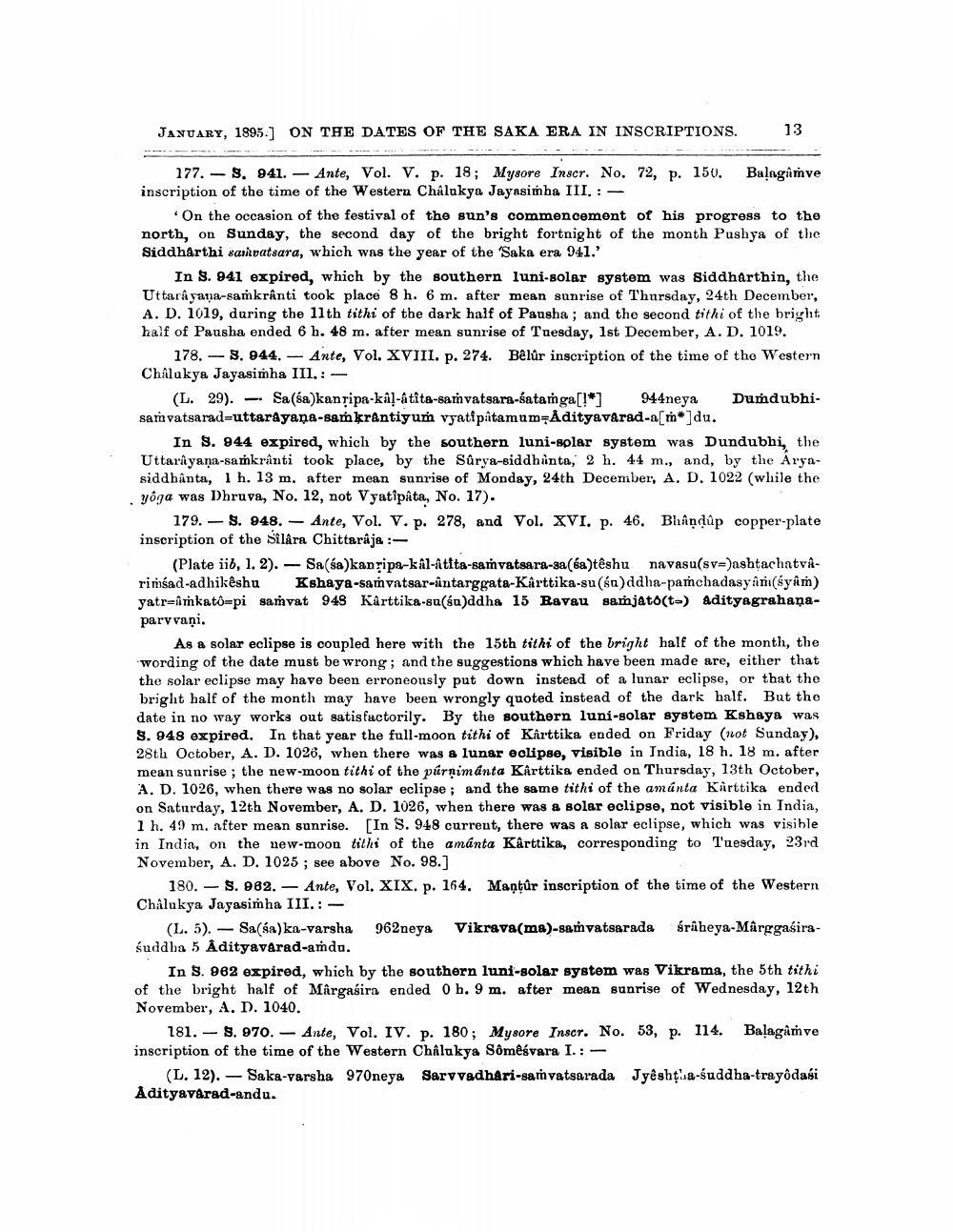________________
JANUARY, 1895.) ON THE DATES OF THE SAKA ERA IN INSCRIPTIONS.
13
177. - S. 941. - Ante, Vol. V. p. 18; Mysore Inscr. No. 72, p. 150. Balagamve inscription of the time of the Western Chalukya Jayasimha III. : -
On the occasion of the festival of the sun's commencement of his progress to the north, on Sunday, the second day of the bright fortnight of the month Pushya of the Siddharthi saivatsara, which was the year of the 'Saka era 941.'
In $. 941 expired, which by the southern luni-solar system was Siddharthin, the Uttara yana-samkranti took place 8 h. 6 m. after mean sunrise of Thursday, 24th December, A. D. 1019, during the 11th tithi of the dark half of Pausha; and the second tithi of the bright half of Pausha ended 6 h. 48 m. after mean sunrise of Tuesday, 1st December, A.D. 1019.
178. - 3. 944. - Ante, Vol. XVIII. p. 274. Bêlûr inscription of the time of the Western Châlukya Jayasimha III.: - (L. 29). -. Sa (sa)kanripa-kal-Atita-samvatsara-satamga[i*
1 9 44neya Dumdubhisamvatsarad-uttarayana-samkrantiyum vyatipatamum=Adityavárad-a[m*]du.
In S. 944 expired, which by the southern luni-solar system was Dundubhi, the Uttarayana-samkranti took place, by the Sürya-siddhanta, 2 h. 44 m., and, by the Aryasiddhanta, 1 h. 13 m. after mean sunrise of Monday, 24th December, A. D. 1022 (while the yoga was Dhruva, No. 12, not Vyatipata, No. 17).
179.- S. 948. - Ante, Vol. V. p. 278, and Vol. XVI. p. 46. Bhindúp copper-plate inscription of the Silara Chittaraja :
(Plate iib, 1.2). - Sa (sa)kanripa-kal-atita-samvatsara-sa (sa)têshu navasu(sv=)ashtachatvarimsad-adhikeshu Kshaya-samvatsar-antarggata-Karttika-su(sn)ddha-pamchadasyar(syam) yatrrimkatô=pi samvat 943 Kârttika-su(so)ddha 15 Bavau samjato(to) Adityagrahaņapary vaņi.
As a solar eclipse is coupled here with the 15th tithi of the bright half of the month, the wording of the date must be wrong; and the suggestions which have been made are, either that the solar eclipse may have been erroneously put down instead of a lunar eclipse, or that the bright half of the month may have been wrongly quoted instead of the dark half. But the date in no way works out satisfactorily. By the southern luni-solar system Kshaya was S. 948 expired. In that year the full-moon tithi of Karttika ended on Friday (not Sunday), 28th October, A. D. 1026, when there was & lunar eclipse, visible in India, 18 h. 18 m. after mean sunrise; the new-moon tithi of the purnimanta Karttika ended on Thursday, 13th October, A. D. 1026, when there was no solar eclipse ; and the same tithi of the amanta Karttika ended on Saturday, 12th November, A. D. 1026, when there was a solar eclipse, not visible in India, 1 h. 49 m. after mean sunrise. [In S. 948 current, there was a solar eclipse, which was visible in India, on the new-moon tithi of the amanta Karttika, corresponding to Tuesday, 23rd November, A. D. 1025 ; see above No. 98.]
180.- S. 982.- Ante, Vol. XIX. p. 164. Mantür inscription of the time of the Western Châlukya Jayasimha III.: -
(L. 5). - Sa(sa)ka-varsha 962neya Vikrava(ma)-samvatsarada srâheya-Märggasirasuddha 5 Adityavárad-amdu.
In S. 962 expired, which by the southern luni-solar system was Vikrama, the 5th tithi of the bright half of Margasira ended 0 h.9 m. after mean sunrise of Wednesday, 12th November, A. D. 1040.
181. - 9. 970. - Ante, Vol. IV. p. 180; Mysore Inscr. No. 53, p. 114. Balagâm ve inscription of the time of the Western Chalukya Sômêśvara I. : -
(L. 12). - Saka-varsha 970neya Sarvvadhari-samvatsarada Jyêshtua-śuddha-trayodasi Adityavárad-andu.




